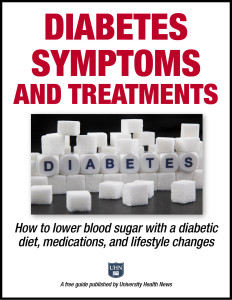The “Normal Blood Sugar Range” May Be Misleading You
A fasting blood sugar test measures the amount of a type of sugar, called glucose, in your blood after you have not eaten for at least 8 hours. Checking for an ideal fasting blood sugar is one of the most commonly performed tests to check for prediabetes and type 2 diabetes. So what should your fasting blood sugar be?
- The normal blood sugar range is 65-99 mg/dL.
- If your fasting blood sugar is between 100 and 125 mg/dL, you have “impaired fasting glucose,” also referred to as “prediabetes.”
- If your fasting blood sugar is more than 126 mg/dL on two or more occasions, you have full-blown diabetes.
Take Control!
Download this expert FREE guide, Diabetes Symptoms and Treatments: How to lower blood sugar with a diabetic diet, medications, and lifestyle changes.
This new report tells you how you can take command of your diabetes, simplify blood sugar management, and make the most of today’s breakthroughs in treatment.
What is prediabetes?
People defined as having impaired fasting glucose/prediabetes are individuals whose blood sugar levels do not meet criteria for diabetes, yet are higher than those considered normal. These people are at relatively high risk for the future development of diabetes. According to the American Diabetes Association, prediabetes is not a disease itself but rather a risk factor “for diabetes as well as cardiovascular disease.”[1] However, they also state that prediabetes can be considered an “intermediate stage” in the diabetes disease process.[1](One might wonder how prediabetes can be a both a risk factor for diabetes and an intermediate stage of the diabetes disease process simultaneously).
In addition to increasing the chance of developing diabetes, it’s well-established that people with impaired fasting glucose/prediabetes are more likely to be overweight or obese, especially with what’s known as abdominal or visceral obesity. They also are more likely to have high triglycerides and/or low HDL cholesterol, and hypertension.[1]
Even blood glucose levels within the normal range can increase risk
There’s a lot more at stake for those with prediabetes, too. Studies show that even those with fasting blood sugar levels towards the high end of the optimal glucose level may be at significantly higher risk. In fact, these cut-offs for what are considered “normal”, prediabetes, and diabetes blood sugar ranges are somewhat arbitrary. The truth is that blood sugar starts damaging body tissues and increasing your risk of numerous diseases even at levels lower than pre-diabetes levels.
A panel of experts gathered by the American College of Endocrinology and the American Association of Clinical Endocrinologists confirmed this in 2008 when they reviewed all the science on pre-diabetes and diabetes. They found that the risks of having elevated blood sugar—including heart disease, strokes, kidney damage, nerve damage, dementia, and cancer—start at numbers much lower than those used to diagnose pre-diabetes or diabetes.[2] In other words, even if your normal fasting glucose level falls within the optimal range, you could still be damaging your heart, brain, and other tissues, and setting yourself up for diabetes symptoms down the road.
What’s an optimal glucose level?
At this point you might be wondering what constitutes an optimal fasting blood sugar range. Some studies indicate that an ideal fasting glucose level is less than 90 mg/dl and likely somewhere around 85 mg/dl.[3,4] However, the optimal fasting blood glucose level likely depends on additional factors related to blood sugar regulation. The fasting blood sugar test only provides a small amount of information regarding how your body handles sugar. There are other important tests, such as the glucose tolerance test, the insulin response test, and the Hemoglobin A1c test, which are considered by many experts to be more important indicators of prediabetes and other problems with blood sugar metabolism.
What to do if your fasting glucose is not within the normal blood sugar range
If your fasting blood sugar is above 85 or 90 mg/dl, don’t panic. There is so much you can do to improve your blood sugar control. It all comes back to the basics: a diabetic diet that boosts intake of healthy foods while decreasing intake of sugar and empty carbs, exercising, and reducing stress. There are many useful natural therapies and dietary approaches for hypoglycemia and lowering blood sugar that we’ve covered in previous articles. For ideas, start by reading the following:
- Suffering From High Blood Sugar Symptoms? Use This Glycemic Index Food List
- The Best Metabolic Syndrome Diet
- Could This Diet for High Blood Sugar Be the Single Healthiest Diet for Everyone?
The post The “Normal Blood Sugar Range” May Be Misleading You appeared first on University Health News.
Read Original Article: The “Normal Blood Sugar Range” May Be Misleading You »
Powered by WPeMatico


